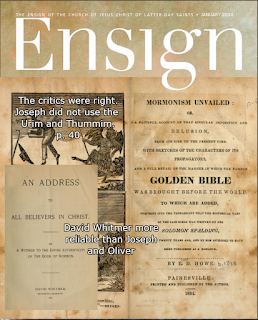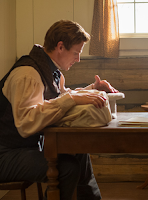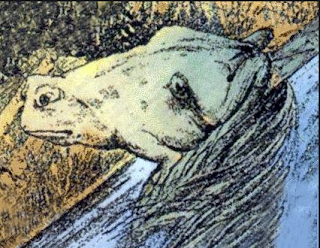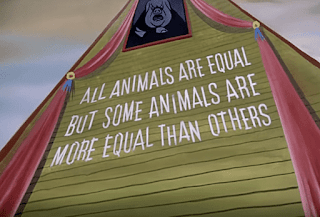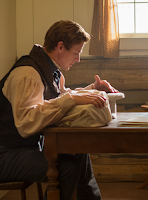What will be the long-term impact of this momentous year? Will anyone outside currently active members of the Church care?
The answer will depend, to some degree, on what they learn about the Restoration.
One narrative is inspiring and has a long history of prophetic affirmations.
The other narrative is bizarre and academic in origins and nature.
Which do you think will be more persuasive and influential for people in the world?
_____
The Restoration itself is a challenging concept for many people. It was unexpected by most of Christianity, but some people hoped and prayed for it. Some anticipated it. Most resisted and rejected it.
Joseph’s explanation that the angel Moroni guided him to the plates, the breastplate and Urim and Thummim, is straightforward and clear. The Book of Mormon, as well as the Doctrine and Covenants and Joseph’s own statements, corroborated by Oliver Cowdery’s statements, are consistent.
They all affirm that Joseph Smith translated the engravings on the plates by the gift and power of God, using the Nephite interpreters Joseph and Oliver called the Urim and Thummim.
For many people, the existence of ancient gold plates is difficult to believe but not impossible. Joseph Smith translating an ancient text is difficult to believe, but not impossible, given his four years of preparation and training, plus the months he spent with the plates, copying and translating characters before Martin Harris arrived to work as a scribe.
Joseph and Oliver stuck with their account their entire lives. Their faithful contemporaries and successors repeatedly re-affirmed that narrative.
| Joseph Smith, not using the Urim and Thummim |
Then, about 15 years ago, a different narrative made its way into the Church. It is based on several statements made by, or attributed to, people who claimed to be witnesses to the translation. The statements claim that Joseph did not use the Urim and Thummim to translate the engravings on the plates.
Instead, he put a seer stone in a hat and read words that appeared. He didn’t consult the plates, which sat under a cloth the whole time (if they were even in the room). He didn’t use the Urim and Thummim.
The new narrative became popular quickly.
Except it’s not a new narrative.
It’s an old narrative, initially promoted by Joseph’s fiercest opponents and, in more recent times, promoted by critics such as the CES Letter, the Tanners, and others.
Now, it’s being taught throughout the Church. We see it in the Ensign, in Church media, lesson manuals, etc.
The new narrative is a direct conflict with what Joseph and Oliver taught. Some have tried to say that when Joseph and Oliver referred to the Urim and Thummim, they actually meant the seer stone.
But that idea contradicts the plain history.
The 1834 book Mormonism Unvailed described two narratives. In one, Joseph produced the seer stone by reading words that appeared on a stone in a hat. In the other, he used the Urim and Thummim, aka the spectacles or interpreters that came with the plates.
Joseph and Oliver repeatedly testified that Joseph used the Urim and Thummim. Never once did they state or imply that Joseph used a seer stone he found somewhere.
_____
Put yourself in the position of a nonmember, or a member who questions his/her faith. Which one of the following scenarios is more believable?
|
Topic
|
Scenario 1
|
Scenario 2
|
|
Urim and Thummim
|
When Moroni hid up the abridged plates in the stone box in the Hill Cumorah in New York, he included special interpreters prepared by the Lord to translate the engravings on the plates. He told Joseph Smith about these, calling them the Urim and Thummim (U&T).
|
When Moroni hid up the abridged plates in the stone box in the Hill Cumorah in New York, he included special interpreters prepared by the Lord to translate the engravings on the plates. He told Joseph Smith about these, but did not call them the Urim and Thummim (U&T). W.W. Phelps or someone else came up with that name and Joseph and Oliver applied it retroactively when they related what Moroni told Joseph Smith.
|
|
U&T vs. seer stone
|
Joseph obtained the U&T and used them to translate characters. Then he used the U&T to translate the 116 pages. When the 116 pages were lost, he had to forfeit the plates and the U&T and lost the gift of translation. Later he received the plates and U&T back again, along with the gift of translation.
|
Joseph obtained the U&T and used them to translate characters, but it was more convenient for him to use a seer stone he had found in a well years previously. When the 116 pages were lost, he had to forfeit the plates and the U&T and lost the gift of translation, although he kept the seer stone. Later he received the plates and U&T back again, or maybe didn’t, depending on whom you believe, but it doesn’t matter because Joseph didn’t use the U&T anyway.
|
|
Plates vs seer stone
|
Using the U&T, he translated the abridged plates in Harmony, then the small plates of Nephi in Fayette.
|
Using the seer stone, he dictated the Book of Mormon text without referring to the plates, which sat nearby covered with a cloth.
|
|
Joseph and Oliver
|
Joseph Smith and Oliver Cowdery always said Joseph translated the engravings on the plates with the U&T. Others said Joseph did not use the U&T but instead used a seer stone in a hat. These observers apparently witnessed a demonstration of the process Joseph conducted to satisfy their curiosity, but not the actual translation because the Lord had forbidden him from showing the U&T and plates to anyone.
|
Joseph Smith and Oliver Cowdery always said Joseph translated the engravings on the plates with the U&T, but that was misleading because actual witnesses said Joseph did not use the U&T but instead used a seer stone in a hat. These observers told the world how the translation was actually done.
|
|
Language
|
Joseph actually translated the engravings on the plates, using his own language as any translator necessarily does.
|
Joseph merely read words that appeared on a seer stone in a hat. The language is Early Modern English which long predated Joseph Smith and which he could not have known.
|
|
Title Page
|
Joseph said the Title Page was a literal translation of the last leaf of the plates.
|
We don’t know how he knew the Title Page was a literal translation or that the Title Page was on the last leaf of the plates because he didn’t use the plates.
|
|
Need for plates
|
Mormon and Moroni abridged the Nephite and Jaredite history so a future prophet could translate the engravings on the plates using the interpreters prepared for that purpose.
|
We don’t know why Mormon and Moroni abridged the Nephite record and gave Joseph the interpreters because he never used them. Instead he just read words that appeared on a seer stone.
|
|
U&T and seer stones two separate things
|
In 1834, the book Mormonism Unvailed identified the two alternative descriptions of the process. When Joseph and Oliver responded to that book in their first essays on Church history, they reaffirmed that Joseph used the U&T.
|
In 1834, the book Mormonism Unvailed identified the two alternative descriptions of the process. When Joseph and Oliver responded to that book in their first essays on Church history, they said Joseph used the U&T, but they really meant he used the seer stone.
|
|
LDS vs RLDS position on U&T
|
Joseph’s contemporaries and subsequent LDS Church leaders have always reaffirmed the account given by Joseph and Oliver. RLDS Church leaders and other dissidents denied Joseph used the U&T and said he used the seer stone in a hat.
|
Joseph’s contemporaries and subsequent LDS Church leaders have always reaffirmed the account given by Joseph and Oliver. RLDS Church leaders and other dissidents denied Joseph used the U&T and said he used the seer stone in a hat.
|
|
LDS scholars
|
In the last few years, LDS scholars have embraced the RLDS position and it has become widespread among LDS people.
|
In the last few years, LDS scholars have embraced the RLDS position and it has become widespread among LDS people.
|
|
Moroni and Cumorah
|
Moroni called the hill in New York “Cumorah.”
|
Moroni did not call the hill in New York “Cumorah.” Parley P. Pratt (or Oliver Cowdery) was mistaken about that.
|
|
Joseph’s first mention of Cumorah
|
Joseph referred to the hill as Cumorah after meeting the angel there months before he got the plates in 1827.
|
Lucy Mack Smith was mistaken when she said Joseph referred to the hill as Cumorah.
|
|
Letter VII
|
As Assistant President of the Church and with the assistance of Joseph Smith, Oliver Cowdery stated it was a fact that the final battles of the Nephites and Jaredites took place in the mile-wide valley west of the Hill Cumorah in New York. (Letter VII)
|
President Cowdery misled the Church when he said it was a fact. He was merely speculating and he was wrong when he wrote Letter VII.
|
|
Letter VII republication
|
Joseph Smith had his scribes copy Letter VII into his journal as part of his life history and approved the republication of Letter VII in the Gospel Reflector and Times and Seasons.
|
Joseph didn’t pay much attention to what Letter VII said and it doesn’t matter because he didn’t know anything about Book of Mormon geography anyway.
|
|
NY depository
—Brigham Young
|
Joseph and Oliver visited the repository of Nephite records in the New York Cumorah multiple times, as Brigham Young explained because he feared the truth would be forgotten.
|
Brigham Young misled the Saints about this because Oliver merely had a vision of this visit but it never really happened. And the vision was of a hill in Mesoamerica anyway.
|
|
NY depository —Wilford Woodruff
|
Wilford Woodruff taught about the repository of Nephite records in the New York Cumorah.
|
Wilford Woodruff misled the Saints about this.
|
|
NY depository —
Heber C. Kimball
|
Heber C. Kimball said he visited the Hill Cumorah in New York and saw the embankments still around it. He also taught about the repository in the hill.
|
Heber C. Kimball misled the Saints about his.
|
|
Joseph’s contemp-oraries
|
All of Joseph’s contemporaries affirmed that the Hill Cumorah was in New York.
|
All these Church leaders misled the Church by repeating false speculation.
|
|
Later Church leaders
|
Every prophet and apostle who has formally addressed the Hill Cumorah, including members of the First Presidency speaking in General Conference, reaffirmed that there is one Hill Cumorah and it is in New York.
|
All these Church leaders misled the Church by teaching their own private, incorrect opinions as the truth.
|
|
Anony-mous articles in the Times and Seasons
|
In 1842, anonymous articles published in the Times and Seasons speculated that Mayan ruins in Central America were left by the Nephites. Joseph Smith was the nominal editor of the Times and Seasons but had little to do with the paper. He was also the named printer but he did not operate the printing press, either.
|
In 1842, anonymous articles published in the Times and Seasons speculated that Mayan ruins in Central America were left by the Nephites. Joseph Smith was the nominal editor of the Times and Seasons so he wrote or approved of the articles, even though they referred to ruins built long after Book of Mormon times.
|
|
Letter VII again
|
In the late 1800s, LDS Church leaders republished Letter VII and began seeking to purchase the Hill Cumorah in New York.
|
In the late 1800s, RLDS scholars determined that the hill in New York could not be the real Cumorah. Instead, the real Cumorah had to be in Mesoamerica.
|
|
Purcha-sing Hill Cumorah
|
In the early 1900s, the LDS Church purchased the Hill Cumorah in New York and reaffirmed its importance as the repository of Nephite records, the scene of the final battles, etc.
|
In the early 1900s, RLDS scholars published books to prove the New York hill could not be the real Cumorah. To reconcile statements from early Church history, there had to be “two Cumorahs.”
|
|
M2C
|
In the mid to late 1900s, LDS scholars adopted the RLDS position of two Cumorahs, with the real Cumorah in Mesoamerica, now known as M2C.
|
In the mid to late 1900s, LDS scholars realized the RLDS scholars were correct while LDS Church leaders were wrong.
|
|
CES
|
LDS scholars taught M2C for decades, while censoring the teachings of the prophets about the New York Cumorah.
|
LDS scholars taught the correct ideas of M2C for decades, while de-correlating the incorrect teachings of the prophets about the New York Cumorah.
|
|
Neutra-lity
|
The Church is currently neutral on the question of Book of Mormon geography but has not stated a specific position about the New York Cumorah.
|
The Church is currently neutral on the question of Book of Mormon geography, which means the living prophets have repudiated the teachings of the dead prophets about the New York Cumorah.
|
|
Evidence—North America
|
Evidence from archaeology, anthropology, geography and geology corroborate the teachings of the prophets about the New York Cumorah.
|
Evidence from archaeology, anthropology, geography and geology demonstrate the fallacy of the teachings of the prophets about the New York Cumorah.
|
|
Evidence—Mesoamerica
|
Evidence from archaeology, anthropology, geography and geology in Mesoamerica has no connection with Book of Mormon descriptions.
|
Evidence from archaeology, anthropology, geography and geology in Mesoamerica has shows lots of correspondences with Book of Mormon descriptions, so long as you assume the Book of Mormon was not translated correctly; i.e., “horses” are actually “tapirs,” “towers” are actually “massive stone pyramids,” etc.
|
